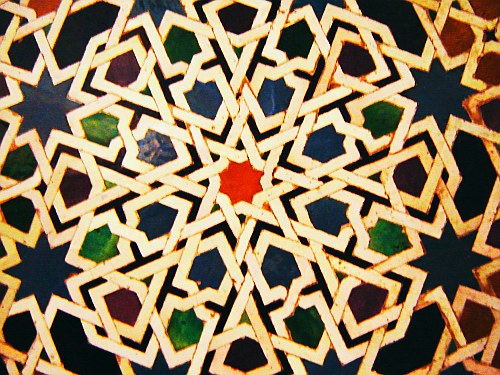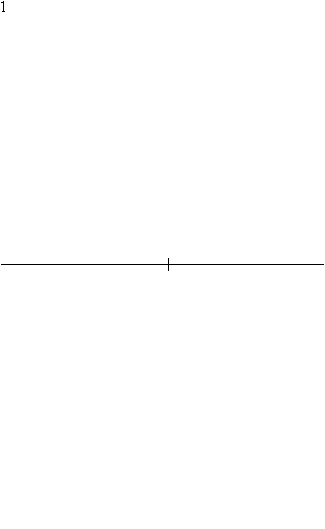Here’s some stuff I added to week267, which should make 2d orbifolds easier to understand:
Take a wallpaper pattern and count two points as “the same” if they’re related by a symmetry. In other
words — in math jargon — take the plane and mod out by the wallpaper
group. The result is a 2-dimensional “orbifold”.
In a 2d manifold, every point has a little neighborhood that looks like the plane. In a 2d orbifold, every point has a little
neighborhood that looks either like the plane, or the plane mod a finite group of rotations and/or reflections.
Let’s see how this works for a few simple wallpaper groups.
I’ll start with the most boring wallpaper group in the world, p1. If
you thought pg was dull, wait until you see p1. It’s the symmetry
group of this wallpaper pattern:
R R R R R R
RRRRRRRRRRRRRRRRRRRRRRRRRRRRRRRRR
R R R R R R
R R R R R R
R R R R R R
RRRRRRRRRRRRRRRRRRRRRRRRRRRRRRRRR
R R R R R R
R R R R R R
R R R R R R
RRRRRRRRRRRRRRRRRRRRRRRRRRRRRRRRR
R R R R R R
This group doesn’t contain any rotations, reflections or glide reflections - I used the letter R to rule those out.
It only contains translations in two directions, the bare minimum allowed by the definition of a wallpaper group.
If we take the plane and mod out by this group, all the points labelled x get counted as “the same”:
R R R R R R
RRRRRRRRRRRRRRRRRRRRRRRRRRRRRRRRR
R R R R R R
R x R x R x R x R x R
R R R R R R
RRRRRRRRRRRRRRRRRRRRRRRRRRRRRRRRR
R R R R R R
R x R x R x R x R x R
R R R R R R
RRRRRRRRRRRRRRRRRRRRRRRRRRRRRRRRR
R R R R R R
Similarly, all these points labelled y get counted as “the same”:
R R R R R R
RRRRRyRRRRRyRRRRRyRRRRRyRRRRRyRRR
R R R R R R
R R R R R R
R R R R R R
RRRRRyRRRRRyRRRRRyRRRRRyRRRRRyRRR
R R R R R R
R R R R R R
R R R R R R
RRRRRyRRRRRyRRRRRyRRRRRyRRRRRyRRR
R R R R R R
So, when we take the plane and mod out by the group p1, we get a rectangle with its right and left edges glued together, and with its top and bottom edges glued together. This is just a torus. A torus is a 2d manifold, which is a specially dull case of a 2d orbifold.
Now let’s do a slightly more interesting example:
T T T T T T
TTTTTTTTTTTTTTTTTTTTTTTTTTTTTTTTT
T T T T T T
T T T T T T
T T T T T T
TTTTTTTTTTTTTTTTTTTTTTTTTTTTTTTTT
T T T T T T
T T T T T T
T T T T T T
TTTTTTTTTTTTTTTTTTTTTTTTTTTTTTTTT
T T T T T T
The letter T is more symmetrical than the letter R: you can reflect it, and it still
looks the same. (If you’re viewing this using some font where the letter T doesn’t have this symmetry,
switch fonts!) So, the symmetry group of this wallpaper pattern, called pm,
is bigger than p1: it also contains reflections and glide reflections along a bunch of parallel lines. So now, all these points labelled x get counted as the same when we mod out:
T T T T T T
TTTTTTTTTTTTTTTTTTTTTTTTTTTTTTTTT
T T T T T T
T x x T x x T x x T x x T x x T
T T T T T T
TTTTTTTTTTTTTTTTTTTTTTTTTTTTTTTTT
T T T T T T
T x x T x x T x x T x x T x x T
T T T T T T
TTTTTTTTTTTTTTTTTTTTTTTTTTTTTTTTT
T T T T T T
and similarly for all these points labelled y:
T T T T T T
TTTyTyTTTyTyTTTyTyTTTyTyTTTyTyTTT
T T T T T T
T T T T T T
T T T T T T
TTTyTyTTTyTyTTTyTyTTTyTyTTTyTyTTT
T T T T T T
T T T T T T
T T T T T T
TTTyTyTTTyTyTTTyTyTTTyTyTTTyTyTTT
T T T T T T
but look how these points labelled z work:
T T T T T T
TTTTTTTTTTTTTTTTTTTTTTTTTTTTTTTTT
T z T z T z T z T z T
T T T T T T
T T T T T T
TTTTTTTTTTTTTTTTTTTTTTTTTTTTTTTTT
T z T z T z T z T z T
T T T T T T
T T T T T T
TTTTTTTTTTTTTTTTTTTTTTTTTTTTTTTTT
T z T z T z T z T z T
There are only half as many z’s per rectangle, since they lie on reflection lines.
Because of this subtlety, this time when we mod out we get an orbifold that’s not a manifold! It’s the torus of the previous example, but now folded in half.
We can draw it as half of one of the rectangles above, with the top and bottom glued together, but not the sides:
TTTT
T .
T .
T .
TTTT
So, it’s a cylinder… but in a certain technical sense the points at the ends of this cylinder count as “half points”:
they lie on reflection lines, so they’ve been “folded in half”.
This particular orbifold looks a lot like a 2d manifold “with boundary”. That’s a generalization of a 2d manifold where some
points - the “boundary” points - have a neighborhood
that looks like a half-plane. But
2d
orbifolds can also have
“cone points” and “mirror reflector” points.
What’s a cone point? It’s like the tip of a cone. Take a piece of
paper, cut it like a pie into n equal wedges, take one wedge, and glue
its edges together! This gives a cone - and the tip of this cone is a
“cone point”. We say it has “order n”, because
the angle around it is not 2π but 2π/n.
Here’s a more sophisticated way to say the same thing: take a regular n-gon and mod out by its rotational symmetries, which
form a group with n elements. When we’re done, the point in
the center is a cone point of order n.
We could also mod out by the rotation and reflection symmetries of the n-gon, which form a group with 2n elements. This is harder to visualize, but when we’re done, the point in the center is a “corner reflector of order 2n”.
To see one of these fancier possibilities, let’s look at the orbifold coming from a wallpaper pattern with even more symmetries:
. . . . . .
.................................
. . . . . .
. . . . . .
. . . . . .
.................................
. . . . . .
. . . . . .
. . . . . .
.................................
. . . . . .
These are supposed to be rectangles, not squares. So, 90-degree rotations are not symmetries of this
pattern. But, in addition to all the symmetries we had
last time, now we have reflections about a bunch of horizontal
lines. We get a wallpaper group called pmm.
What orbifold do we get now? It’s a torus
folded in half twice! That sounds scary, but it’s not really. We can draw it as a quarter of one of the rectangles above:
....
. .
....
Now no points on the edges are glued together. So, it’s just a
rectangle. The points on the edges are boundary points, and the corners are corner reflection points of order 4.
In a certain technical sense — soon to be explained — points on the edges of this rectangle count as “half points”, since they lie on a reflection line and have been folded in half. But the corners count as “1/4 points”, since they lie on two reflection lines, so they’ve been folded in half twice!
This is where it gets really cool. There’s a way to define an “Euler characteristic” for orbifolds that generalizes the usual formula for 2d manifolds. And, it can be a fraction!
The usual formula says to chop our 2d manifold into polygons and compute
That is: the number of vertices, minus the number of edges, plus the number of faces.
In a 2d orbifold, we use the same formula, but with some modifications. First, we require that every cone point or corner
reflector be one of our vertices. Then:
- We count edges and vertices
on the boundary for 1/2 the usual amount.
- We count a cone point of
order n as 1/nth of a point.
- We count a corner reflector of
order 2n as 1/(2n)th of a point.
The idea is that these features have
been “folded over” by a certain amount, so they count for a
fraction of what they otherwise would.
It turns out that if we calculate the Euler characteristic of a 2d
orbifold coming from a wallpaper group, we always get zero. And, there are just 17 possibilities!
In fact wallpaper groups are secretly
the same as 2d orbifolds with vanishing Euler characteristic!
So, they’re not just mathematical curiosities: they’re almost
as fundamental as 2d manifolds.
The torus and the cylinder, which we’ve already seen, are two examples. These are well-known to have Euler characteristic zero. Of course, we should be careful: now we’re dealing with the cylinder as
an orbifold, so the points on the boundary count as “half points” — but its Euler characteristic still vanishes. A more interesting example is the square we get from the group pmm. Let’s
chop it into vertices, edges, and one face, and figure out how much
each of these count:
1/2
1/4-------1/4
| |
| |
1/2| 1 |1/2
| |
| |
1/4-------1/4
1/2
So, the Euler characteristic of this orbifold is
This is different than the usual Euler characteristic of a rectangle!



Re: This Week’s Finds in Mathematical Physics (Week 267)
So they get to be called Euclidean 2-orbifolds.
Hmm, nice looking notes. Looks like you need to put Morse theory into the mix: